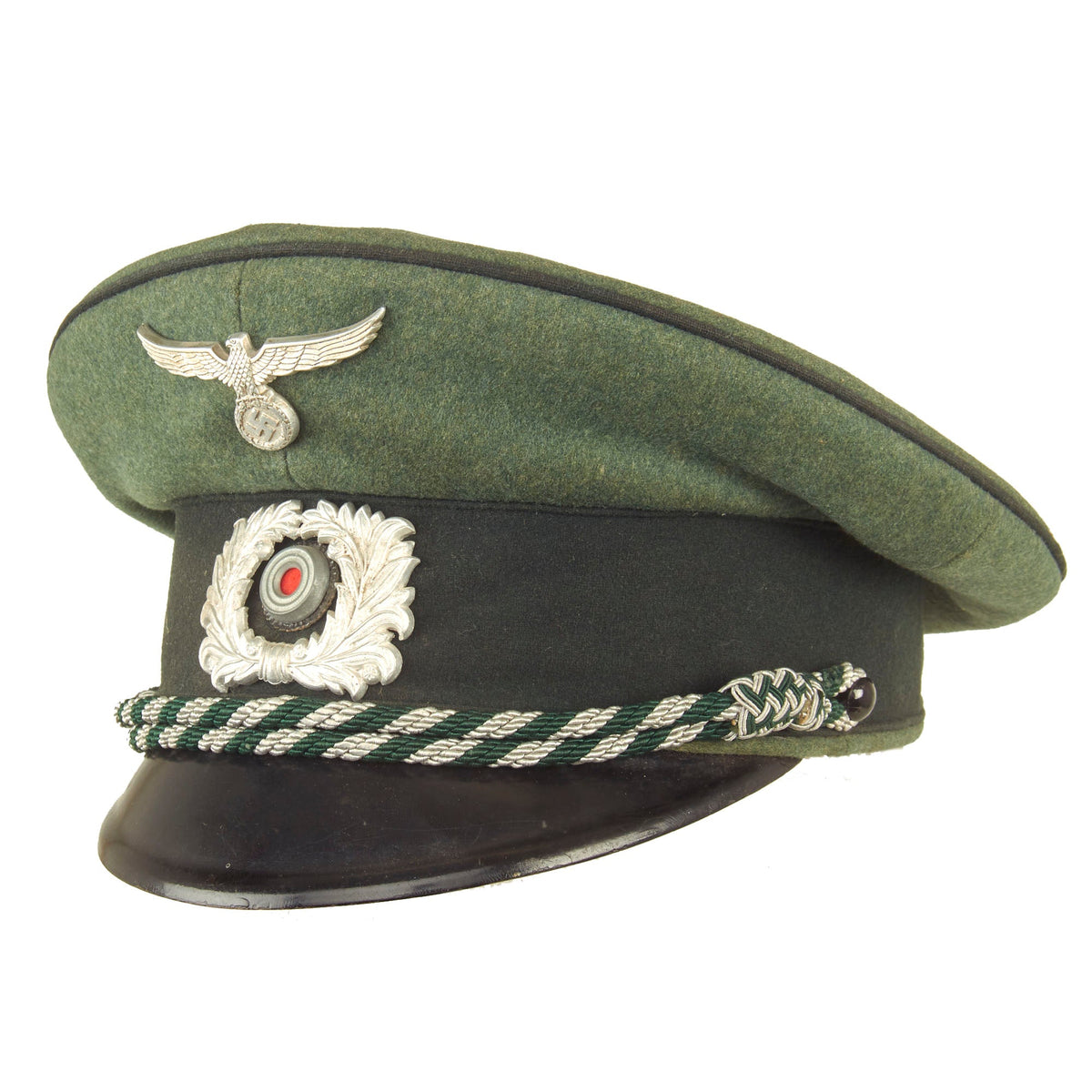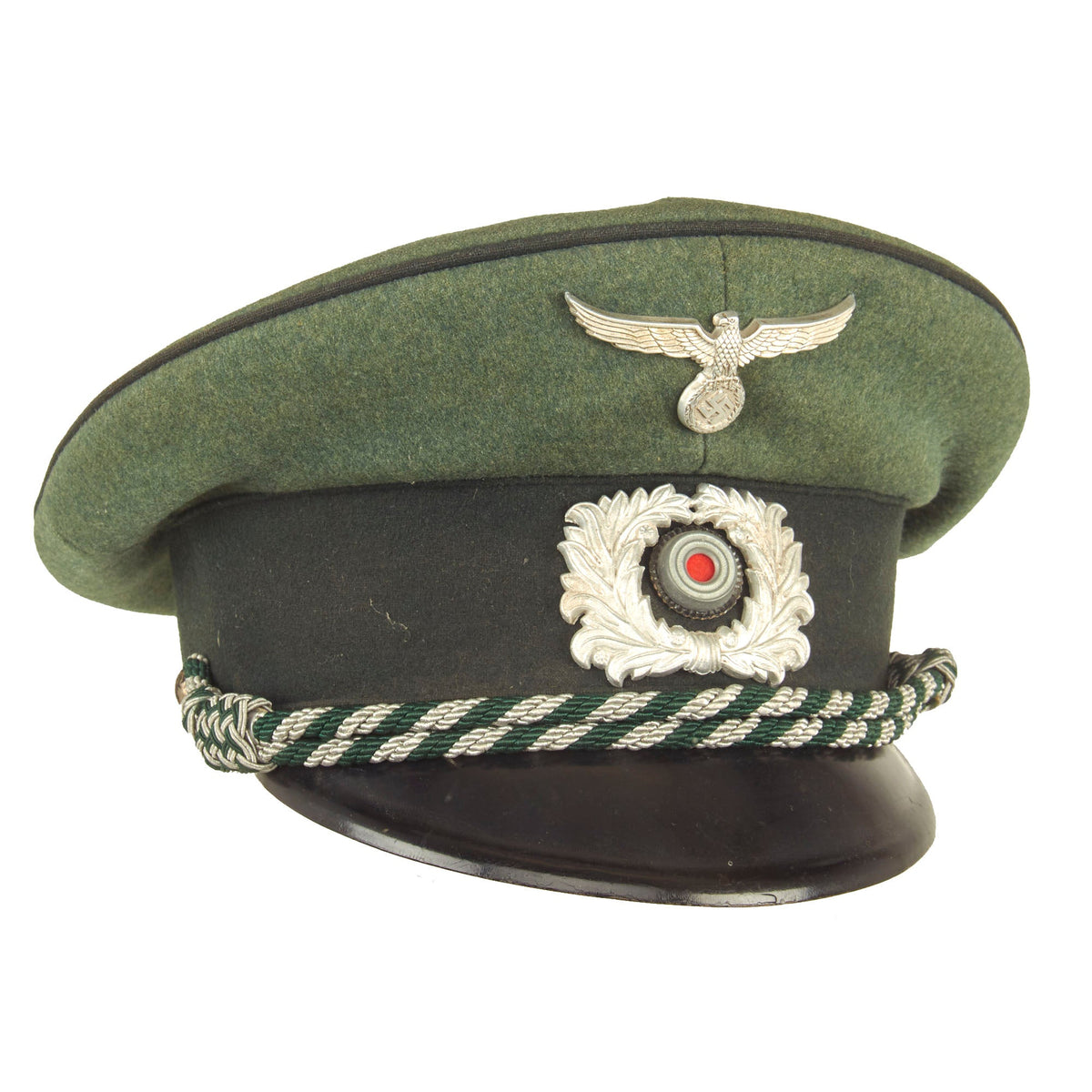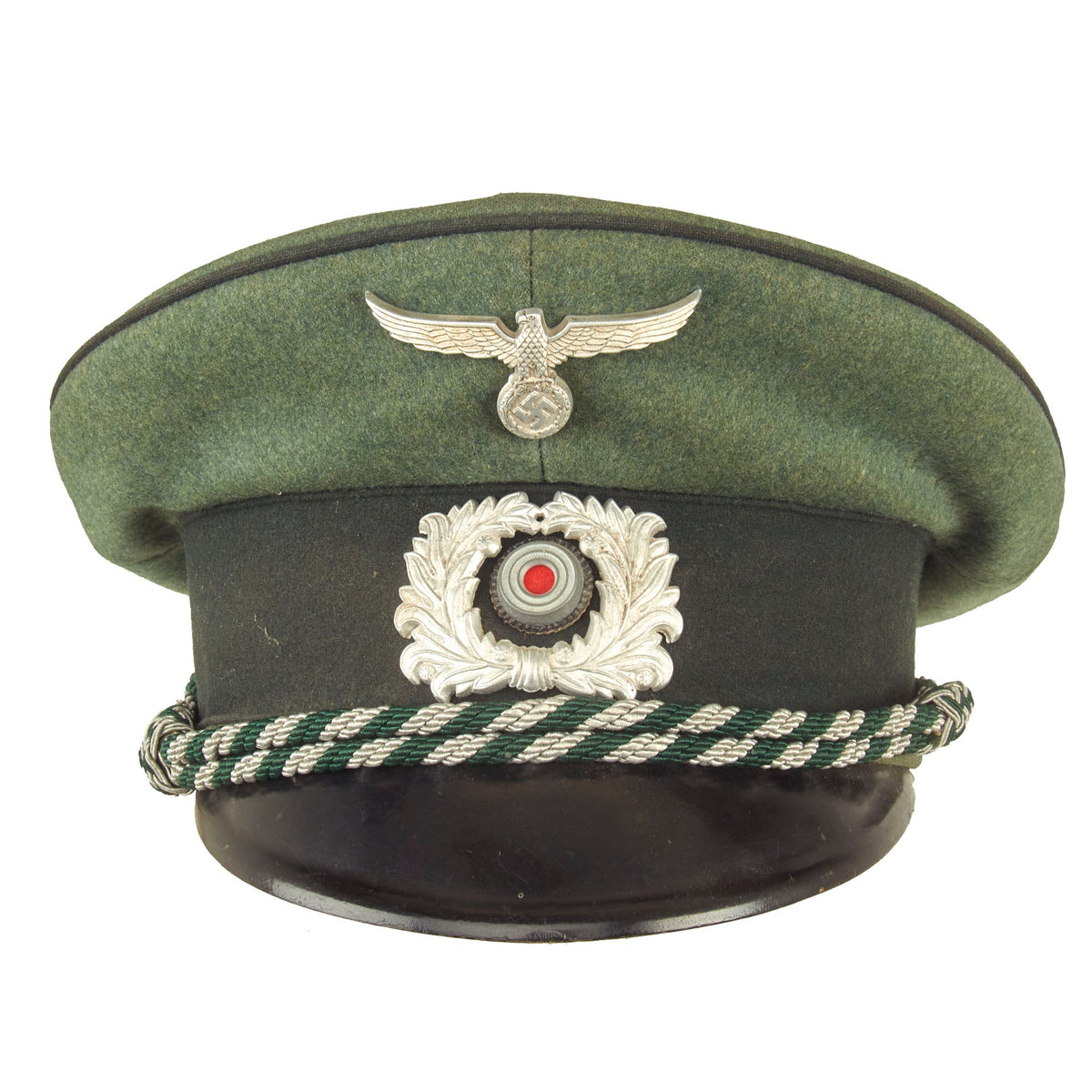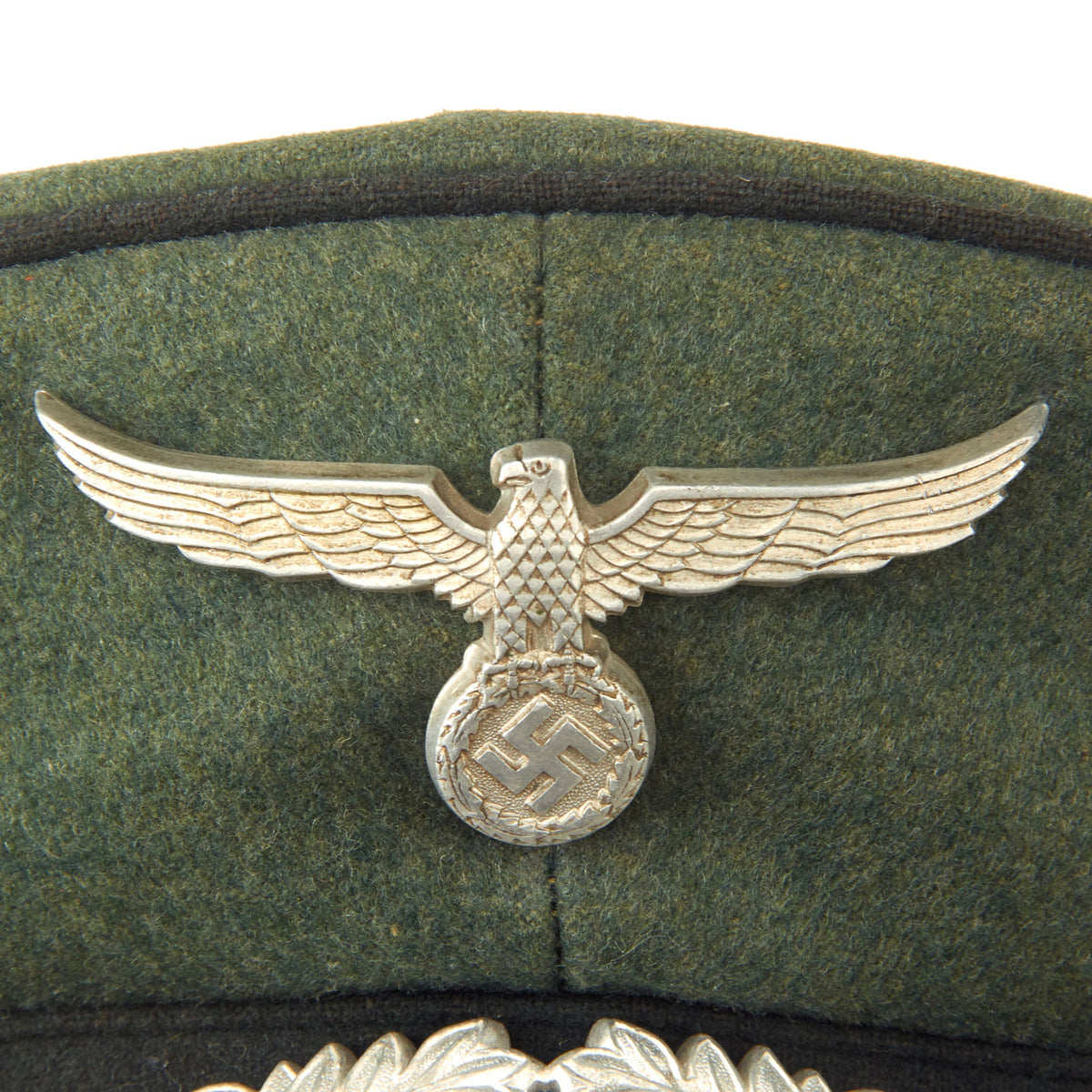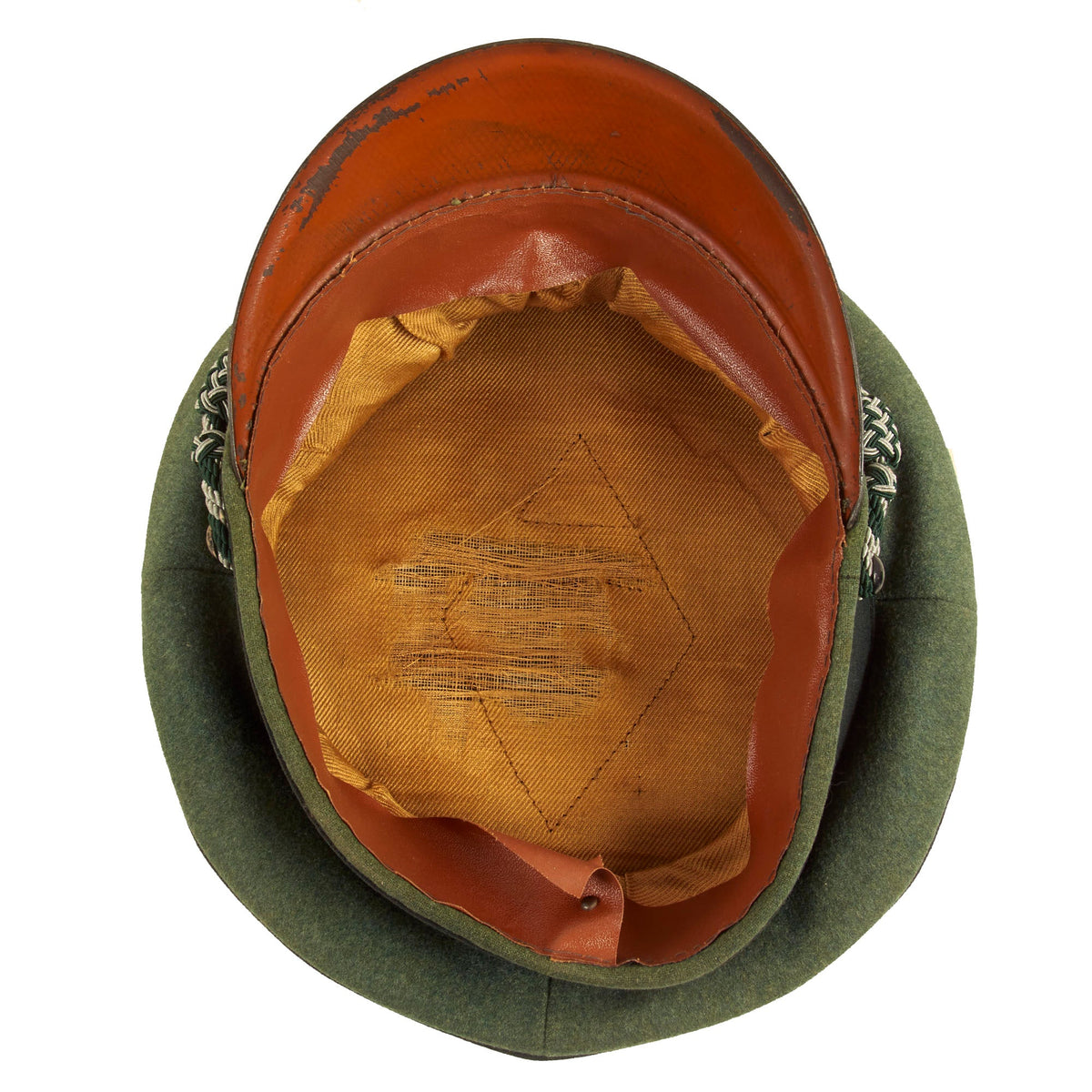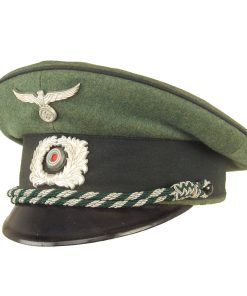Original German WWII Customs Officer Schirmmütze Visor Cap Original Items
$ 695,00 $ 208,50
Original Item: Only One Available. During the Pre-WWII years in Germany, virtually all aspects of the government fell under control of the NSDAP, and the Customs service was no exception. Here we have a very nice example of a German WWII Era Customs Officer Schirmmütze (Peaked Cap). The basic construction is very similar to the Heer Officer Visor cap. It features the typical field gray worsted wool construction with a forest green band and a traditional high forward crown. The also has matching Waldgrün (Forest Green) piping along the top edge and flanking either side of the band, common to all versions of the customs cap.
It is decorated with a well detailed silvered aluminum eagle insignia on the front crown, which faces to the left, with upswept wings, unique to the Customs Service. It is perched on a wreathed “mobile” Swas (swas), as with most Reichsadler designs. The cap band has a silver washed alloy acanthus leaf wreath, surrounding an alloy tri-color cockade with a red felt insert in the center. There is a twisted green and silver braided “chinstrap” secured by two pebbled aluminum buckles. We assume this is for an officer, but there is not much information out there regarding the rank structure. We have also seen these advertised as “NCO”, but we believe those would have a leather chinstrap. It has the standard “vulcanfibre” peak / visor, which is black gloss on the top and brown on the bottom with a cross-hatched texture.
The interior is lined with gold colored rayon twill, which shows wear and staining, particularly in the center, where the material is somewhat threadbare and torn. The plastic sweat shield is completely missing, though the stitching is still present. The sweatband is textured faux leather oilcloth, and is in very good condition, though a bit stiff. The stitching is well retained, and there is a small 57 cm size tag at the very back of the sweatband at the seam.
The cap presents beautifully, and does not look to have any mothing or major wear on the exterior. The colors are still well retained and vibrant, and the cap has a beautiful shape. The main condition issue is the wear and staining to the lining, which can only be seen on the underside of the cap.
A very nice example of a classic hat worn by the German Customs Service Officers during the WWII Era.
More on the German Customs Service:
The German Customs Service can be traced back to 1834 when a Customs Union was formed to allow the separate German States to trade amongst themselves without trade and tariff taxes, while still imposing import trade taxes on other European nations. With the unification of the German States into a single nation in 1871 the Customs Service became a national paramilitary organization, under control of the Reichsfinanzministerium, (National Finance Ministry), in Berlin. The national Customs Service was still responsible for imposing and collecting import trade taxes but was also tasked with border defense duties.
In 1936 the Customs Service was reorganized and given further policing responsibilities including the apprehension of individuals attempting to escape from the NSDAP’s yoke. The German Customs service was divided into two separate branches with one branch consisting of the Landzollbeamte (Land Customs Officials), which was subdivided into the Zollgrenzschutz (Land Customs Border Guards), and the Wasserzollbeamte (Water Customs Officials), and the second branch consisting of the remaining Zollbeamte (Customs Officials).
On June 17TH 1936, Reichsführer-SS Heinrich Himmler was appointed to the newly created position of Chef der Deutschen Polizei im Reichsministerium des Innern (Chief of the German Police in the National Ministry of the Interior), effectively giving him full control of all police agencies within Germany including the Customs service. As a result of this appointment new regulations were instituted, in July 1936, to bring about uniformity in dress and included new insignia for the Customs personnel.
The German Schirmmütze Visor Cap:
The visor cap (Schirmmütze) was an important part of the headgear worn by German uniformed military, civil, paramilitary and political organizations during the Third Reich. This was the standard cloth headgear worn as a part of the service uniform. Visor caps were worn outdoors as well as indoors, and were often required to be worn by all personnel on duty. Visor caps were made in versions specific to each organization and were often further differentiated through the use of insignia, colored piping, or style of chin cord, to indicate rank, role or branch. The insignia used on these caps ranged from simple stamped metal emblems, to elaborate hand embroidery. Visor caps were issued to enlisted soldiers and NCOs in the military and in some other organizations. Officers had to purchase their own hats, and lower ranks could choose to purchase caps that were of a higher quality than the rather basic, issue examples. The private purchase caps were generally made in very high quality, with fine materials. A wide variety of fabrics were used, from Trikot and doeskin, to heavy wool, or even lightweight white fabric for summer wear. In the military, issue of these caps was generally suspended shortly after the outbreak of the war, but they continued to be worn by some troops until the end of the war.
Fast Shipping with Professional Packaging
Thanks to our longstanding association with UPS FedEx DHL, and other major international carriers, we are able to provide a range of shipping options. Our warehouse staff is expertly trained and will wrap your products according to our exact and precise specifications. Prior to shipping, your goods will be thoroughly examined and securely secured. We ship to thousands clients each day across multiple countries. This shows how we're dedicated to be the largest retailer on the internet. Warehouses and distribution centres can be located throughout Europe as well as the USA.
Note: Orders with more than one item will be assigned a processing date depending on the item.
Before shipping before shipping, we'll conduct a thorough inspection of the items you have ordered. Today, the majority of orders will be delivered within 48 hours. The delivery time will be between 3-7 days.
Returns
The stock is dynamic and we cannot completely manage it because multiple stakeholders are involved, including our factory and warehouse. So the actual stock may alter at any time. It's possible that you may not receive your order once the order has been made.
Our policy is valid for a period of 30 days. If you don't receive the product within 30 days, we are not able to issue a refund or an exchange.
You can only return an item if it is unused and in the same state as the day you received it. You must have the item in its original packaging.
Related products
Uncategorized
Uncategorized
Uncategorized
Armored Burgonet Helmet & Polearm from Scottish Castle Leith Hall Circa 1700 Original Items
Uncategorized
Uncategorized
Uncategorized
Uncategorized
Band of Brothers ORIGINAL GERMAN WWII Le. F.H. 18 10.5cm ARTILLERY PIECE Original Items
Uncategorized
Uncategorized
Uncategorized
Uncategorized
Uncategorized
Uncategorized
Australian WWII Owen MK1 Machine Carbine SMG Custom Fabricated Replica with Sling Original Items
Uncategorized
Armoured Fighting Vehicles of the World: AFVs of World War One (Hardcover Book) New Made Items
Uncategorized
Uncategorized
Uncategorized
Uncategorized
Angolan Rebel 1970s era 60mm Inert Display Mortar from Angolan Civil War Original Items
